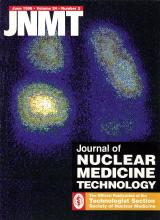Abstract
Objective: SPECT of the thoracic and lumbar spine has become a common bone imaging procedure in nuclear medicine, however, SPECT of the cervical spine is used to a much lesser degree. This is due in part to the normal lordotic curvature of the cervical spine. We present a technique for cervical spine SPECT that corrects the normal curvature and produces adequate tomographic images.
Methods: Two SPECT studies of the cervical spine of a normal volunteer were acquired. One study had the volunteer lying flat on the tomographic table (HOR), while the other had her head on the angled headrest of the tomographic table (ANG). The neck support of the headrest has an angulation of 50° relative to the horizontal axis of the table. Both studies were processed using the same Butter-worth filter. The HOR study was reoriented to a sagittal angle perpendicular to the axis of the table, while the ANG study was obliquely reoriented perpendicular to the angle of the cervical spine.
Results: All vertebral bodies or posterior elements are seen to the same degree on contiguous slices in coronal images of the ANG study. In the HOR study, different portions of the vertebral bodies and/or posterior elements are evident on contiguous slices.
Conclusions: The ANG technique produces coronal SPECT images of the cervical spine that are considerably more useful than those of the HOR technique. The use of neck angulation to straighten out the cervical curve, combined with reorientation of SPECT images to the axis of the cervical spine, allows SPECT imaging to be effectively accomplished.







